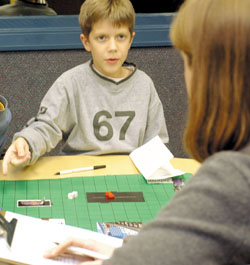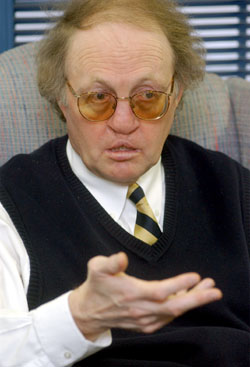
Wilkerson stuttering research refutes once-common notions

Landry Gwin, 9, works in therapy to overcome speech disfluency, or stuttering. The process includes teaching parents to slow the often hectic pace of communication at home. (photo by Dana Johnson)

Ed Conture, Ph.D., has been studying the frustrating phenomenon of stuttering for more than 30 years. (photo by Dana Johnson)
Nine-year-old Landry Gwin has stuttered since he began speaking. His parents, Kevin and Suzanne Gwin, hoped he would outgrow it, but the problem persisted. Landry receives good grades in school, so his parents were not concerned about his learning ability or intellectual development. But, like many parents who make their way to Conture, they were concerned with how he might be perceived by others.
“We know what a wonderful person Landry is, but a lot of people will judge you by your outward expression,” Suzanne Gwin says. “We didn’t want people to judge Landry based on the way he talks.” And, she says, listening to “adults who stutter, who just struggle through a conversation, I’ve always felt sorry for them because they never learned to master it. When Kevin and I heard our own child stutter, we didn’t want that for him. We wanted him to be able to overcome it.”
Two months ago the Gwins came to the Vanderbilt Bill Wilkerson Center for Otolaryngology and Communication Sciences to see one of the leading researchers and clinicians in stuttering, or speech disfluency.
Edward G. Conture, Ph.D., professor of Hearing and Speech Sciences, has been studying the frustrating phenomenon of stuttering for more than 30 years, looking for the causes and developing methods to overcome it. His recent book, “Stuttering: Its Nature, Diagnosis and Treatment” (Allyn & Bacon), reviews his research and clinical findings during that time.
There are three main components of speech: thoughts, which turn into a plan or code, which leads to execution. For many years, researchers, including Conture, focused on the execution segment, looking specifically at the physiological mechanics of speech for problems in the lips, tongue or larynx, but no real evidence of cause was found.
Research has also debunked theories, that stuttering is linked to lower intelligence, that it begins with mimicry or that one child can “catch it” from others, or that certain letter or word sounds create the stumbling block.
Current investigation focuses on the planning stages of language. Stuttering, it seems, starts even before sounds are attempted, Conture says. Speech requires near-simultaneous processing of sounds, words and sentence structure or grammar into a code, Conture says. If there is a problem in one or more of the links in the chain of planning for speech-language production, the code will not develop and speech will be interrupted, or stuttered.
Stuttering commonly begins between 30 and 36 months of age and usually appears by age 7. It’s likely to appear when a child’s vocabulary has a growth spurt, say from 200 to 500 words, or after they start putting two or more words together in a sentence, Conture says.
If stuttering continues into adulthood, Conture says, it’s likely because learned behaviors—compensatory strategies and reactions—have persisted, or developmental delays have never resolved.
While the exact causes are unknown, Conture and other researchers have strong clues. Genetics may influence communication by as much as 50 percent, Conture says. “Some children are born with tendencies to be taller, larger, etc., and others with tendencies for earlier developing, more advanced communication skills,” he says.
A child who stutters in a family of non-stutters can be “like being a violin-playing child in a football-playing family,” Conture says. It’s a communicative mismatch between the child’s abilities and the family’s communicative demands. If parents and siblings communicate at fairly high or complex levels, if they do so quickly or interrupt the stuttering child while he’s talking, or if the child has a tendency towards hesitations, errors or repetitions in their speech, Conture says, “there will be significant difficulties” with speech fluency. “Parents do not cause stuttering, but they can aggravate or exacerbate it.”
“As a general rule,” Conture says, “there’s very little that slowing down communicatively won’t help, allowing more time to call up words, construct the grammar, form sentences.” He delivers this message in weekly group sessions with the Gwins and other parents trying to find ways to help their children overcome stuttering.
After just a couple of months, Landry’s improvement has been slow. But, his parents are committed to a long-term investment; it might take two years to correct what Landry has learned during his first nine years of life. “So far I think we’re doing the right thing,” Suzanne Gwin says. “I think we’re on the right track.”













